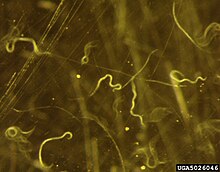Aphelenchoides ritzemabosi
| Aphelenchoides ritzemabosi | |
|---|---|
 |
|
| Scientific classification | |
| Kingdom: | Animalia |
| Phylum: | Nematoda |
| Class: | Secernentea |
| Subclass: | Diplogasteria |
| Order: | Tylenchida |
| Superfamily: | Aphelenchoidea |
| Family: | Aphelenchoididae |
| Subfamily: | Aphelenchoidinae |
| Genus: | Aphelenchoides |
| Species: | A. ritzemabosi |
| Binomial name | |
|
Aphelenchoides ritzemabosi |
|
Aphelenchoides ritzemabosi (Black currant nematode, Chrysanthemum foliar nematode, Chrysanthemum leaf nematode, Chrysanthemum nematode, Chrysanthemum Foliar eelworm) is a plant pathogenic nematode. It was first scientifically described in 1890 in England. This nematode has a wide host range. Among the most important species affected are Chrysanthemums and strawberries. A. ritzemabosi is a migratory foliar feeding nematode. It can feed both ectoparasitically and endoparasitically, with the later causing the most significant damage. When adequate moisture is present, this nematode enters the leaves and feeds from inside the tissue. Typical damage is characterized by necrotic zones between the veins of the leaves. Its lifecycle is short; only ten days from egg to mature adult. A single female can lay as many as 3,500 eggs. This pest can be difficult to control. Host plant resistance, hot water treatments, and predatory mites are recommended.
First described in England in 1890, it was given the name Aphelenchus olesistus by Ritzema-Bos in 1893. In 1908, Markinowski grouped A. olesisyus, A. fragariae, and A. omerodis under the common name A. omerodis. A. olesistus was recognized as an individual species and given the current name Aphelenchoides ritzemabosi by Schwartz in 1911. This species may also be known by the following synonyms: Aphelenchus ritzemabosi Schwartz 1911, Pathoaphelenchus ritzemabosi (Schwartz 1911), Steiner 1932, Aphelenchoides (Chitinoaphelenchus) ritzemabosi (Schwartz 1911) Fuchs 1937, Pseudaphelenchoides ritzemabosi (Schwartz 1911) Drozdovski 1967, Tylenchus ribes Taylor 1917, Aphelenchus ribes (Taylor 1917) Goodey 1932, Aphelenchoides ribes (Taylor 1917) Goodey 1933, Aphelenchus phyllophagus Stewart 1921
Aphelenchoides ritzemabosi ranges in length from 0.7 to 1.2 mm with the females of the species having the potential to be slightly longer than the males. Male A. ritzemabosi are often wider than females. The head is sharply differentiated from the body in that it is noticeably wider than the neck. This nematode has four lateral incisures. Females have at least two rows of oocytes and the spicule on the male nematodes is a short ventral process without outgrowths.
A. ritezmabosi has a wide host range of almost 200 plant species, and is an important disease in chrysanthemum and other ornamentals. Other ornamental hosts of A. ritzemabosi are anemones, asters, carnations, Chinaster, cinerarias, coneflowers, crassulas, creeping bellflower, dahlias, delphiniums, elders, lupines, monkeyflower, phlox, pouchflower, rhododendrons, sages, Siberian wallflower, water peperomia, and zinnias. A common symptom of A. ritezmabosi is seen when the nematode is feeding in the foliar tissue. Angular lesions are formed, which are chlorotic at first then turn necrotic as the feeding persists. A sign that an A. ritzeambosi nematode is feeding in the bud of a plant is brown scars on the bud and surrounding tissue. The nematode also produces secretions that have the ability to cause several other symptoms in infested plants including shortening of inter-nodes, creating a bushy appearance, browning and failure of the shoot to grow, as well as distorted leaf formation.
...
Wikipedia
